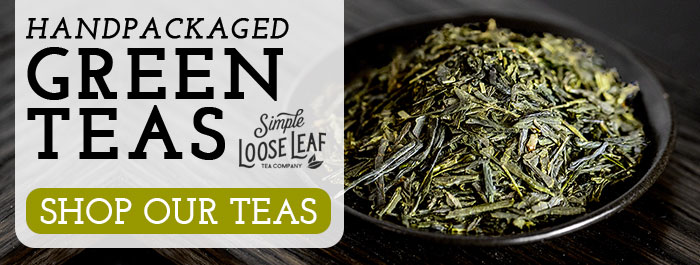What is Green Rooibos Tea? Health Benefits & How to Brew
Rooibos is a herbal tea made from a plant grown in South Africa. The most common and wide-spread type is the fermented red rooibos. However, there is an non-fermented green type too. Green rooibos is not only rare, it’s quite new, may poses a higher antioxidant level, has a milder and fresher flavor and it’s very easy to brew. Sounds like a miracle tea? Studies say, it might be. Besides, the producers created it to rival the benefits and flavor of green tea.
What is the Difference Between Red and Green Rooibos Tea
Both green and red rooibos come from the same plant from South Africa. Red rooibos is a traditional drink. Because of its benefits and pleasant flavor, local people have been harvesting and drying the leaves and stalks for centuries. However, it didn’t enjoy popularity outside South Africa until the last century[1]. It’s still less available compared to real green or black tea. On the other hand, green rooibos is a new drink, and very rare compared to the traditional red type. Today, drinking rooibos tea is not related to medicinal purposes only. This plant is an ingredient in hundreds of delicious blends, thus more and more enjoyed for its flavor as well.
Even though red and green rooibos share similar health benefits, their chemical composition is slightly different. This is because the oxidation process. Green rooibos is dried right after harvesting to preserve the color, flavor and antioxidants.
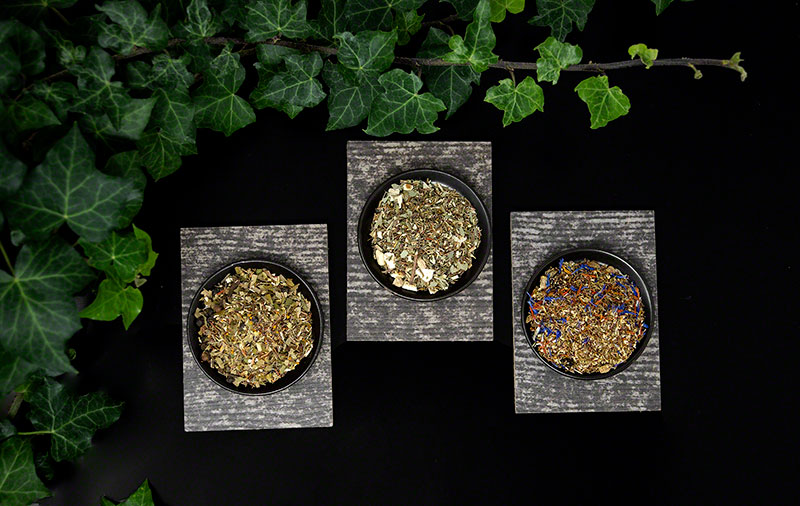
Green Rooibos Tea
What is the Difference Between Green Tea and Green Rooibos Tea
Green rooibos is not a green tea. Only Camellia sinensis plant can be used for making real tea types—white, green, yellow, oolong, black and dark. Green Rooibos tea comes from the African bush Aspalathus linearis. While green tea is grown in more than 70 countries around the world, green rooibos comes exclusively from South Africa. Same as green tea, green rooibos undergoes a heating process that stops oxidation that makes tea dark and changes chemical structure.
Both real green tea and green rooibos contain high levels of antioxidants and may be beneficial for health. However, the antioxidants in them are different. Unlike green tea, green rooibos is completely caffeine free. This makes it a safe drink for the evenings, before sleep or even for some pregnant and breastfeeding women. In fact, rooibos is usually one of rare teas suitable for infants and children as well.
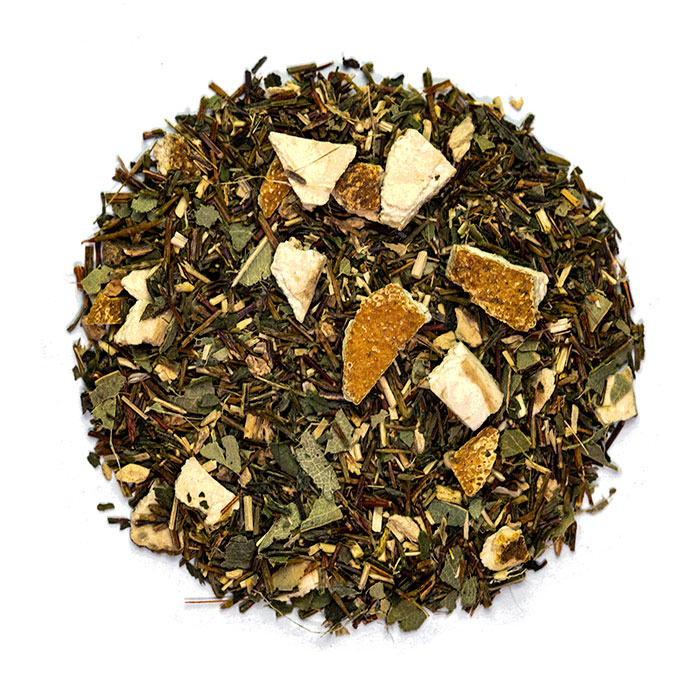
Winter Green Rooibos – green rooibos tea blend
What are the Benefits of Rooibos Tea
Antioxidant, antimutagenic[2], anti-steatotic and anti-inflammatory activity[3] are some of the benefits you may get from this tea. Rooibos may have the ability to fight free radicals and protect cells from DNA damage. Animal studies show that rooibos is indeed, a tea with huge potential. Results say it might play an important role in fighting skin, liver, colon and oesophagus cancers, diabetes and obesity. While traditional red rooibos shares very similar benefits to the green type, studies say that the green one might inhibit the growth of cancer cells at a slightly higher speed[4].
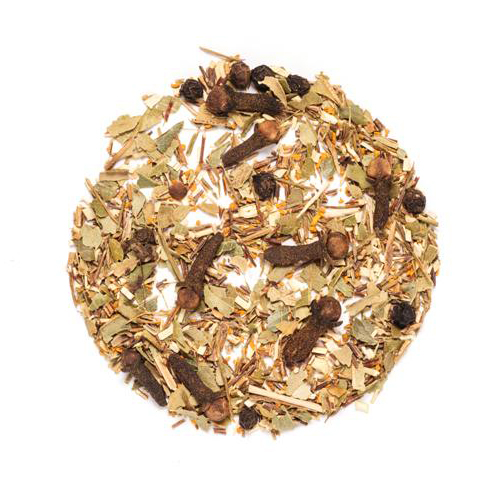
Rusty Roots – green rooibos tea blend
Antioxidants in Rooibos Tea
Two important antioxidants, aspalathin and nothofagin are found abundantly only in green rooibos. Although the red type has a vast potential in treating many health conditions, green type is more abundant in antioxidants. You may think of them as green and black tea, both healthy beverages, both made from the same plant, but with different chemical composition.
Aspalathin, an antioxidant in rooibos plant may help improve glucose and lipid metabolism[5], making it beneficial for dealing with obesity, type 2 diabetes mellitus and insulin resistance[6]. Another study showed it may be helpful in preventing stress-induced weight loss and may have potential in preventing neurodegenerative diseases[7].
Nothofagin is found only in rooibos bush and red beech from New Zealand. High amounts in green rooibos might be very useful in treating vascular inflammation in diabetics[8]. Caution is needed when drinking high amounts though, as both of them might interact with some medicine and cause side effects making some conditions worse.
An article published in the Food & Function journal in 2018 called rooibos a functional food for heart health. In fact, the first rooibos human clinical trial in the world was focused exactly on cardiovascular health. Results showed that 6 cups of this tea per day during a period of 6 weeks “improved lipid profile and redox status in in adults at risk for developing cardiovascular disease”[9].
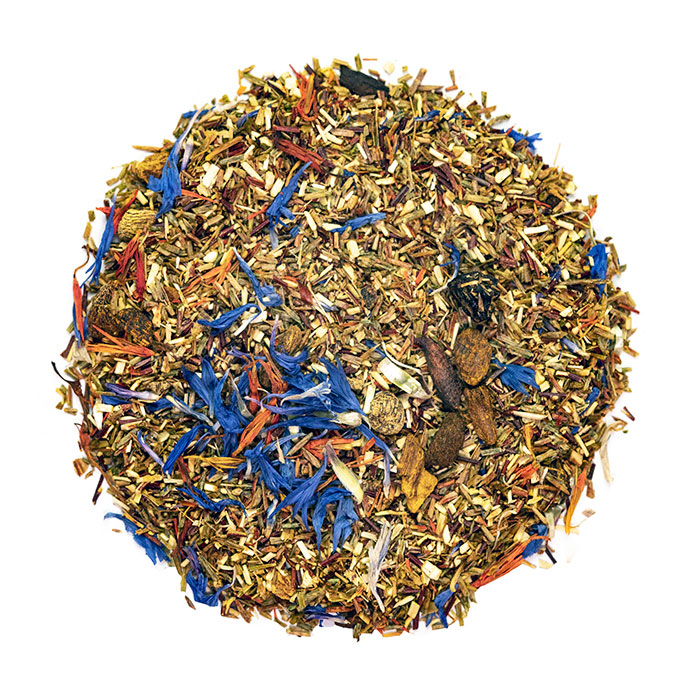
Green Berry Delight – green rooibos tea blend
How to Brew Green Rooibos Tea
Regardless the benefits, rooibos is one of those teas you will either love or hate. While many people enjoy the lightly sweet and earthy flavor or red bush, other might find it unpleasant. Green type is less earthy, lighter and has a recognizable delicate sweetness too, with no bitterness. It could be a great choice for anyone looking to enjoy the benefits of rooibos tea, but with a lighter and less earthy flavor. Both of them blend well with other ingredients, making them a delicious base for many fruity, flowery and spicy blends. Among all herbal teas, it is the most similar to (a light) green tea in flavor.
Brewing is very easy and doesn’t require too much time or skills. Use a teaspoon of rooibos tea per cup of water. Brew it for 5-10 minutes using almost boiling water at around 203-213 °F. Even if you steep it too long, it won’t become bitter. To extract more nutrients, you may brew it longer while simmering over low fire. Unlike intense red of red rooibos or bright yellowish green of green tea, color of green rooibos is golden orange, intense and clear. Even the dry leaves are not purely bright green, but have a light yellow-orange hue.
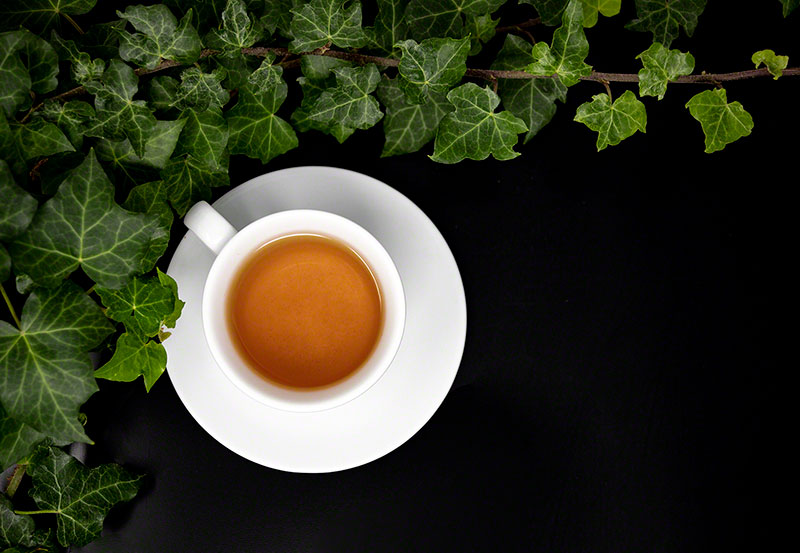
A cup of green rooibos tea
While the red rooibos blends great with milk, the green one is best enjoyed pure. Both are great as iced tea—refreshing, lightly sweet and caffeine free. To maximize the benefits try brewing it the regular way first.
Related articles:
Disclaimer
The purpose of this article is not to diagnose or treat any diseases, or to replace an opinion of a professional doctor. Never self-treat any diseases, or drink large quantities of tea, real or herbal, if you are suffering from serious diseases, are pregnant or breastfeeding. Every person is different and it’s impossible to make a general statement about the benefits or side-effects.
References
[1] https://www.sciencedirect.com/science/article/pii/S0254629911001086
[2] https://www.cansa.org.za/rooibos-research-around-the-world/
[3] https://www.ncbi.nlm.nih.gov/pubmed/31153588
[4] https://www.cansa.org.za/rooibos-research-around-the-world/
[5] https://www.ncbi.nlm.nih.gov/pubmed/29388183
[6] https://www.ncbi.nlm.nih.gov/pubmed/31153588
[7] https://journals.plos.org/plosone/article?id=10.1371/journal.pone.0087061



